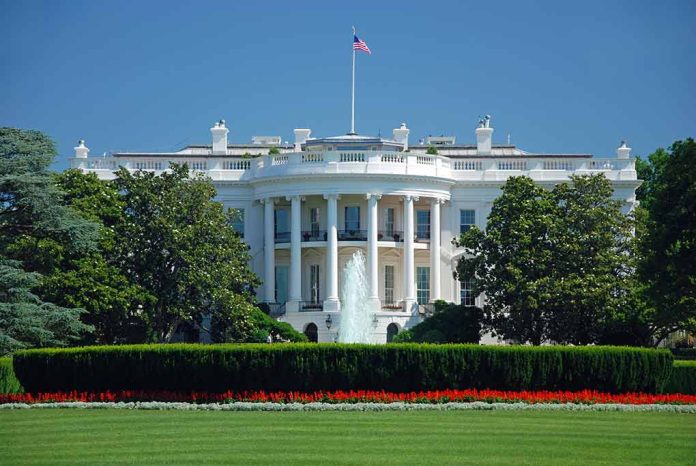
The White House plans to overhaul its press briefing room by taking control of the seating chart from the White House Correspondents’ Association, making room for digital influencers alongside traditional journalists.
Key Takeaways
- The Trump administration will implement its own seating chart for the White House briefing room, ending the White House Correspondents’ Association’s traditional role in this process.
- The restructuring aims to reflect modern media consumption habits by including digital outlets, influencers, and “new media” alongside legacy press.
- Legacy media outlets will have reduced prominence, while right-leaning outlets and digital platforms will gain greater access.
- The White House states it wants to “balance disruption with responsibility” while critics worry about potential threats to press independence.
- The move comes amid declining public trust in traditional mass media and shifting news consumption patterns toward digital platforms.
Taking Control of the Press Room
In a significant departure from longstanding tradition, the White House plans to take over management of the briefing room seating chart in the coming weeks. This responsibility has historically been handled by the White House Correspondents’ Association (WHCA), which has maintained an independent system for determining which news outlets receive the coveted seats. The change represents a direct shift in power from the press corps to the administration itself, raising questions about the delicate balance between government transparency and press autonomy in the democratic process.
The restructuring is part of a broader effort to reshape White House communications strategy to reflect contemporary media consumption patterns. Few right-leaning outlets currently have assigned seats in the briefing room, with exceptions being Fox News, The Daily Caller, and the New York Post. Under the new arrangement, the White House intends to incorporate a wider range of media voices, including digital-first publications, podcasters, and social media personalities who have built substantial audiences outside traditional press channels.
The White House Press Briefing room is owned by US taxpayers – not the leftist members of the elitist White House Correspondents Association
The idea they put a name plate on these chairs can call them "their seats" is an outrage
I say go to open seating https://t.co/jcND18UxOO
— Sean Spicer (@seanspicer) March 30, 2025
New Media Landscape
The administration’s plan specifically includes allocating space for outlets like The Daily Wire, Axios, and Semafor, alongside social media influencers who command large followings. This shift acknowledges the changing ways Americans consume news and information in 2025, with many turning away from legacy television networks and newspapers in favor of podcasts, online publications, and social media commentators. The move also follows the White House’s January announcement establishing a dedicated “new media seat” in the briefing room.
Tim Pool, a prominent right-wing YouTuber with a substantial following, is among those mentioned as part of the new press rotation. The practical implications of this change extend beyond the seating chart itself. Reporters without assigned seats often face challenges during briefings, including limited visibility and difficulty engaging with press secretaries. The current configuration frequently forces some journalists to stand in aisles, where late arrivals may block their view or access to the podium.
Concerns About Press Independence
The White House Correspondents’ Association has expressed significant concerns about the changes. In addition to losing control of the seating chart, the WHCA previously ceded management of pool reports to the administration. WHCA President Eugene Daniels, a journalist with POLITICO, has been vocal about potential threats to journalistic independence under the new arrangements, particularly regarding government selection of pool reporters who provide coverage for all media when space is limited. “WHCA cannot ensure that the reports filed by government-selected poolers will be held to the same standards that we have had in place for decades,” expressed Daniels.
The administration maintains that these changes are necessary adaptations to the evolving media environment, where trust in traditional press has declined significantly. A senior White House official emphasized that they seek to strike a careful balance between innovation and responsibility. The restructuring comes at a time when the administration has faced criticism for previously denying access to certain outlets, including the Associated Press, Reuters, and Huffpost, for key events – raising questions about whether the new system will enhance or restrict press freedom.
Adapting to Changing Media Trust
The press room reconfiguration reflects broader changes in the American media landscape, where traditional outlets face unprecedented challenges to their authority and reach. Gallup polling shows that public trust in mass media has reached historic lows, with many Americans turning to alternative sources they perceive as more aligned with their values or perspectives. The White House appears to be responding to this shift by creating more opportunities for newer media platforms that have demonstrated significant audience engagement.
Sources:
White House to Take Control of Briefing Room Seating Chart, Add Influencers
White House To Take Charge Of Briefing-Room Seating Chart
White House Will Decide Which Reporters Get Briefing Room Seats: Report













